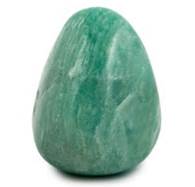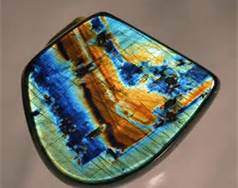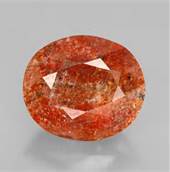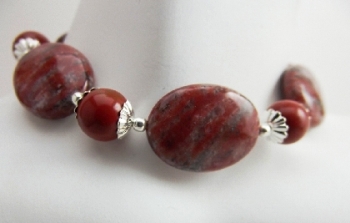Departments
Search
Follow Us
Tags
Latest Highlights
IBH
Gems of the Feldspar Mineral Group
Feldspar is the most common mineral found at the surface of the earth. There are two basic varieties of feldspar: Orthoclase (Potassium Feldspar) and Plagioclase (Calcium-Sodium Feldspar). The term feldspar came from German meaning “field split.” Very well named as feldspars have a bad property for gemstones-perfect cleavage. Here are some of the most common gems of the feldspar group.
Amazonite
 Amazonite was originally found in Brazil, hence its name. It is an opaque greenish sodium feldspar (plagioclase). It is sensitive to pressure (perfect cleavage). Hardness is 6, which makes it moderately soft for jewelry use. As can be seen from the picture, the color distribution is not even.
Amazonite was originally found in Brazil, hence its name. It is an opaque greenish sodium feldspar (plagioclase). It is sensitive to pressure (perfect cleavage). Hardness is 6, which makes it moderately soft for jewelry use. As can be seen from the picture, the color distribution is not even.
Labradorite
 Labradorite is obviously named after the province in Canada. This is also a plagioclase feldspar with a property called “shiller” (labradorescence) in metallic tints. This form of feldspar is the base mineral in the igneous rock “gabbro.” Spectrolite is a tradename for a form of labradorite found in Finland (see picture).
Labradorite is obviously named after the province in Canada. This is also a plagioclase feldspar with a property called “shiller” (labradorescence) in metallic tints. This form of feldspar is the base mineral in the igneous rock “gabbro.” Spectrolite is a tradename for a form of labradorite found in Finland (see picture).
Moonstone
 Moonstone is a potassium feldspar (orthoclase) with a white shimmer, similar to moonshine, hence the name. This stone like all feldspars is sensitive to pressure and moderately soft (Mohs = 6). Moonstone can also occur in cats-eye varieties.
Moonstone is a potassium feldspar (orthoclase) with a white shimmer, similar to moonshine, hence the name. This stone like all feldspars is sensitive to pressure and moderately soft (Mohs = 6). Moonstone can also occur in cats-eye varieties.
Sunstone
 Sunstone is also called aventurine feldspar and belongs to the plagioclase group. It is also frequently confused with the artificial glass – goldstone. Most frequently sunstone occurs in a reddish color. Some varieties of feldspar are translucent to transparent and may be faceted instead of being cut en cabochon.
Sunstone is also called aventurine feldspar and belongs to the plagioclase group. It is also frequently confused with the artificial glass – goldstone. Most frequently sunstone occurs in a reddish color. Some varieties of feldspar are translucent to transparent and may be faceted instead of being cut en cabochon.
These gems make for a great variety of styles and colors that can be used in the making of jewelry. In the terms of gemology, these are all considered “colored” stones, as opposed to diamonds, which are the only “white” stones.
Posted by Rasmussen Gems and Jewelry LLC
Tags: Amazonite, Felcspar, gemstones, Handmade, handmade gemstones, labradorite, moonstone, sunstone
Posted in Information
2 Responses to “Gems of the Feldspar Mineral Group”
Leave a Reply
You must be logged in to post a comment.



Great post John, thanks for sharing!
Very informative. I love stones, minerals, rocks. Sun stone is new to me and very pretty, I am going to have to try and find some to make a pretty shiny with.